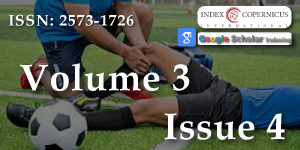Contractions of athlete’s foot and its muscle oxygenation
Main Article Content
Abstract
Sustained isometric contractions of skeletal muscles produce intramuscular pressures that leads to blood flow restriction. In result an active muscle feels deficit of oxygen what bring to muscle fatigue. In another side during exercise we have physiological contradiction between raising of oxygen demand by working muscle and restriction of blood flow due to vessel pressing. To clarify this issue many research has been performed based mainly on measurement of blood flow in muscle tissue. The purpose of this study was to assess real-time changes in muscle oxygenation during a sustained isometric contractions of dorsiflexor muscle of low (30%), moderate (60%) and submaximal (90%) intensity. Experiments were conducted using the subject’s dominant (right) leg. Volunteers was recruited from eight male students of USIPC (age: 19±2 years, weight: 75±6 kg). Tissue oxygenation index (StO2) were recorded from the tibialis anterior using NIRS device (NONIN). Saturation was higher at 30% compared with both 60% and 90% MVC at all time points after start exercise and higher at 60% than 90%. Oxygen consumption (VO2) permanently increased from slow (30%) to moderate (60%) and submaximal contractions. After cessation of the each contraction there was a large and immediate hyperemic response. Rate of StO2 increasing after effort cessation what reflects the resaturation of hemoglobin which depend on integrity and functionality of vascular system and reflects blood vessel vasodilation. StO2 restoration rate permanently increased from slow (30%) to moderate (60%) and submaximal contractions too. At last on final stage of experiment arterial occlusion test has been performed to determine the minimal oxygen saturation value in the dorsiflexors. Oxygen saturation reached a 24±1.77% what is significantly higher than StO2 after 60 and 90%MVC.
So, we can conclude that oxygen saturation at 60% and 90% MVC are similar and sharply decreased after start of exercise. It means that after 60% MVC take place occlusion of blood vessels due to intramuscular pressure. Oxygen consumption of active muscle increased depend on intensity of exertion according to increasing of oxygen demand. StO2 resaturation rate (Re) permanently increased from slow (30%) to moderate (60%) and to submaximal contractions. Re increasing after effort cessation reflects the resaturation of hemoglobin which depend on integrity and functionality of vascular system and reflects blood vessel vasodilation.
Article Details
Copyright (c) 2018 Paiziev A, et al

This work is licensed under a Creative Commons Attribution-NonCommercial 4.0 International License.
Degens H, Salmons S, Jarvis JC. Intramuscular pressure, force and blood flow in rabbit tibialis anterior muscles during single and repetitive contractions. Eur J Appl Physiol Occup Physiol. 1998; 78: 13–19. Ref.: https://goo.gl/eUqRUj
Saltin B, Radegran G, Koskolou MD, Roach RC. Skeletal muscle blood flow in humans and its regulation during exercise. Acta Physiol Scand. 1998; 162: 421–436. Ref.: https://goo.gl/ge49wk
McNeil CJ, Allen MD, Olympico E, Shoemaker JK, Rice CL. Blood flow and muscle oxygenation during low, moderate, and maximal sustained isometric contractions. Am J Physiol Regul Integr Comp Physiol. 2015; 309: R475–R481. https://goo.gl/AozWqc
Sjogaard G, Savard G, Juel C. Muscle blood flow during isometric activity and its relation to muscle fatigue. Eur J Appl Physiol Occup Physiol. 1988; 57: 327–335. Ref.: https://goo.gl/53U3bd
Vollestad NK, Wesche J, Sejersted OM. Gradual increase in leg oxygen uptake during repeated submaximal contractions in humans. J Appl Physiol. 1990; 68: 1150–1156. Ref.: https://goo.gl/Uo62ve
Wesche J. The time course and magnitude of blood flow changes in the human quadriceps muscles following isometric contraction. J Physiol. 1986; 377: 445–462. https://goo.gl/x6eyPe
Hughson RL, Shoemaker JK, Tschakovsky ME, Kowalchuk JM. Dependence of muscle V ̇O2 on blood flow dynamics at onset of forearm exercise. J Appl. Physiol. 1996; 81: 1619–1626. Ref.: https://goo.gl/rmjvnb
Wolf M1, Ferrari M, Quaresima V. Progress of near-infrared spectroscopy and topography for brain and muscle clinical applications. J Biomed Opt. 2007; 12: 062104. Ref.: https://goo.gl/q4VbzR
Hamaoka T1, McCully KK, Quaresima V, Yamamoto K, Chance B. Near-infrared spectroscopy/imaging for monitoring muscle oxygenation and oxidative metabolism in healthy and diseased humans. J Biomed Opt. 2007; 12: 062105. Ref.: https://goo.gl/VsJ8Cc
Gerovasili V, Dimopoulos S, Tzanis G, Anastasiou-Nana M, Nanas S. Utilizing the vascular occlusion technique with NIRS technology. International Journal of Industrial Ergonomics. 2010; 40: 218–222 Ref.: https://goo.gl/rdPkpu

